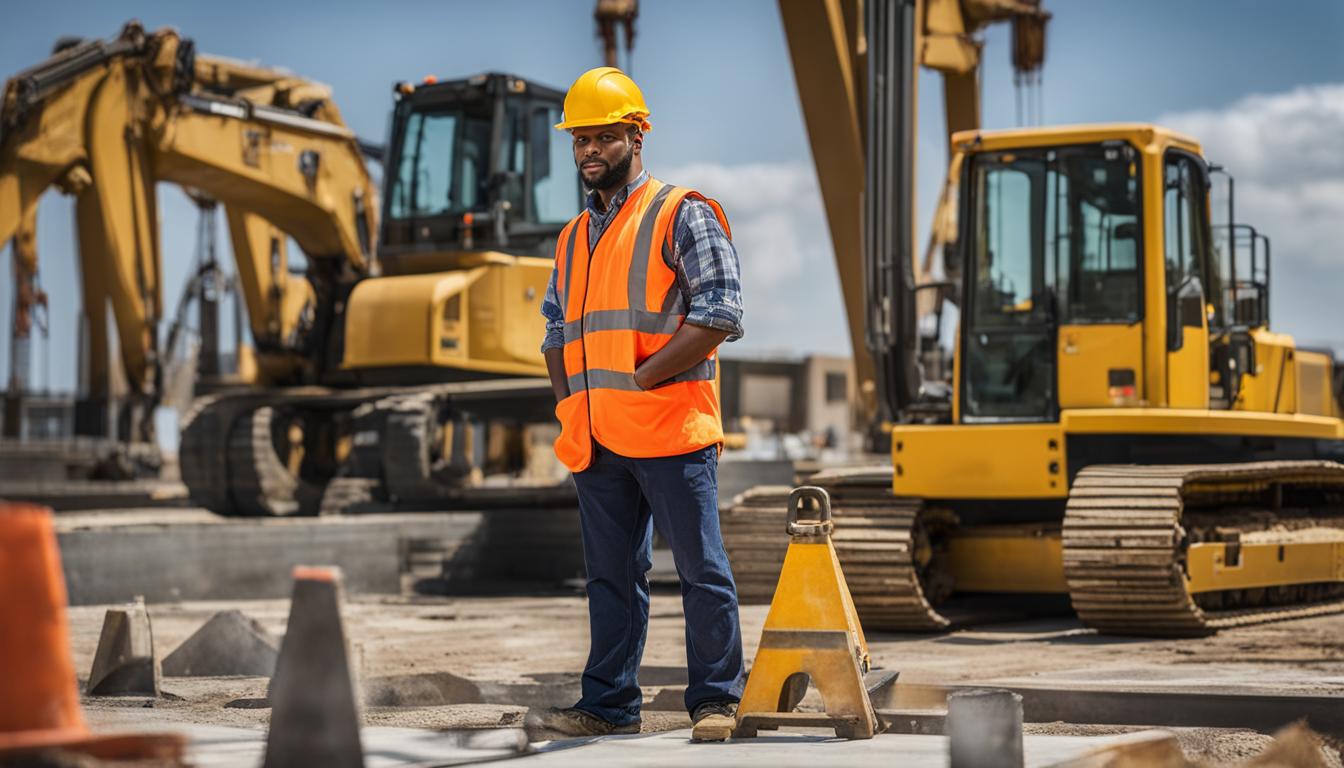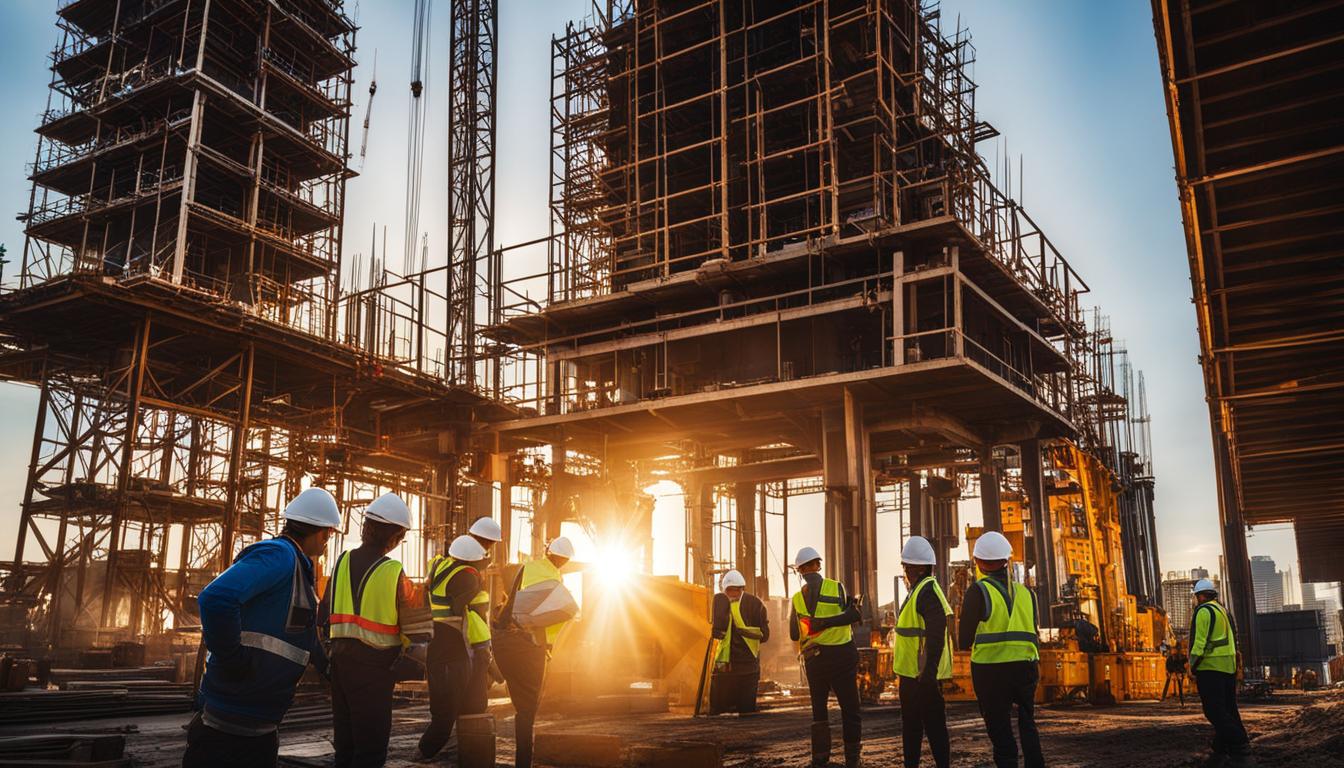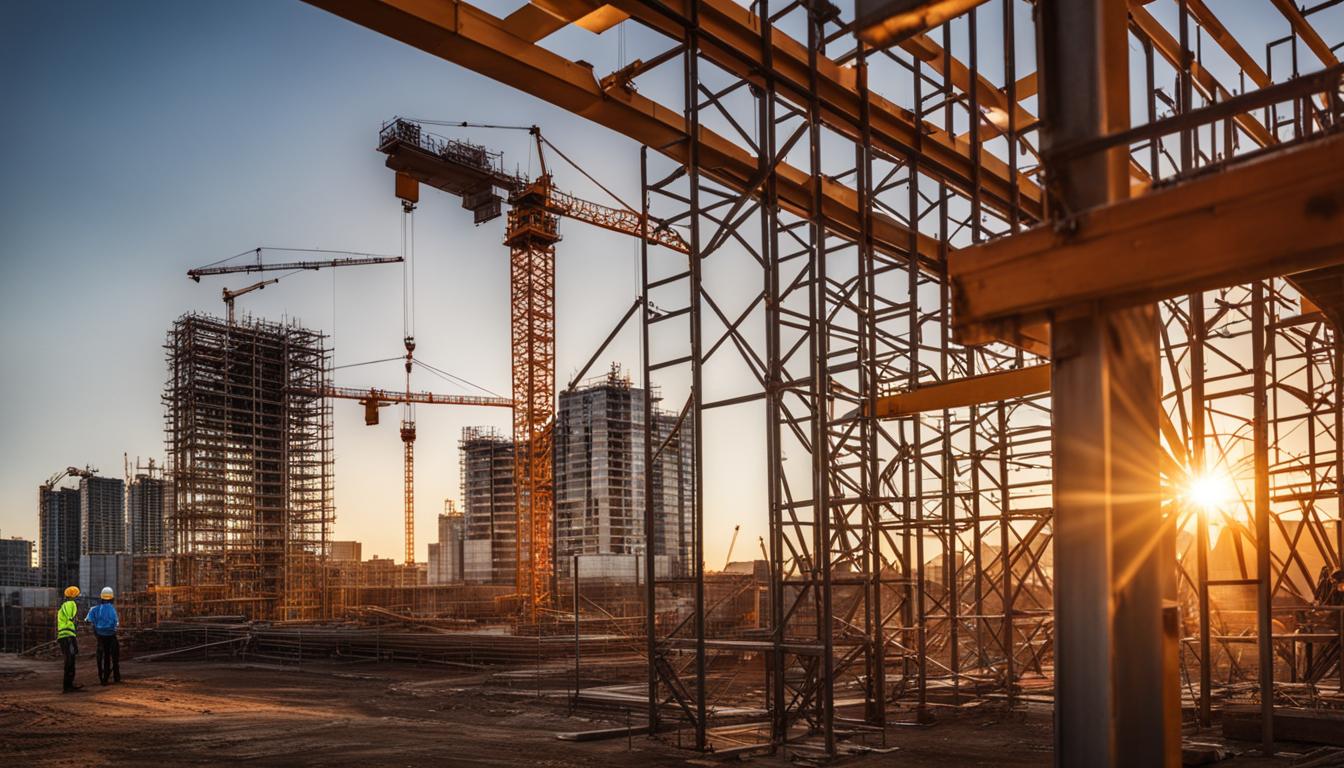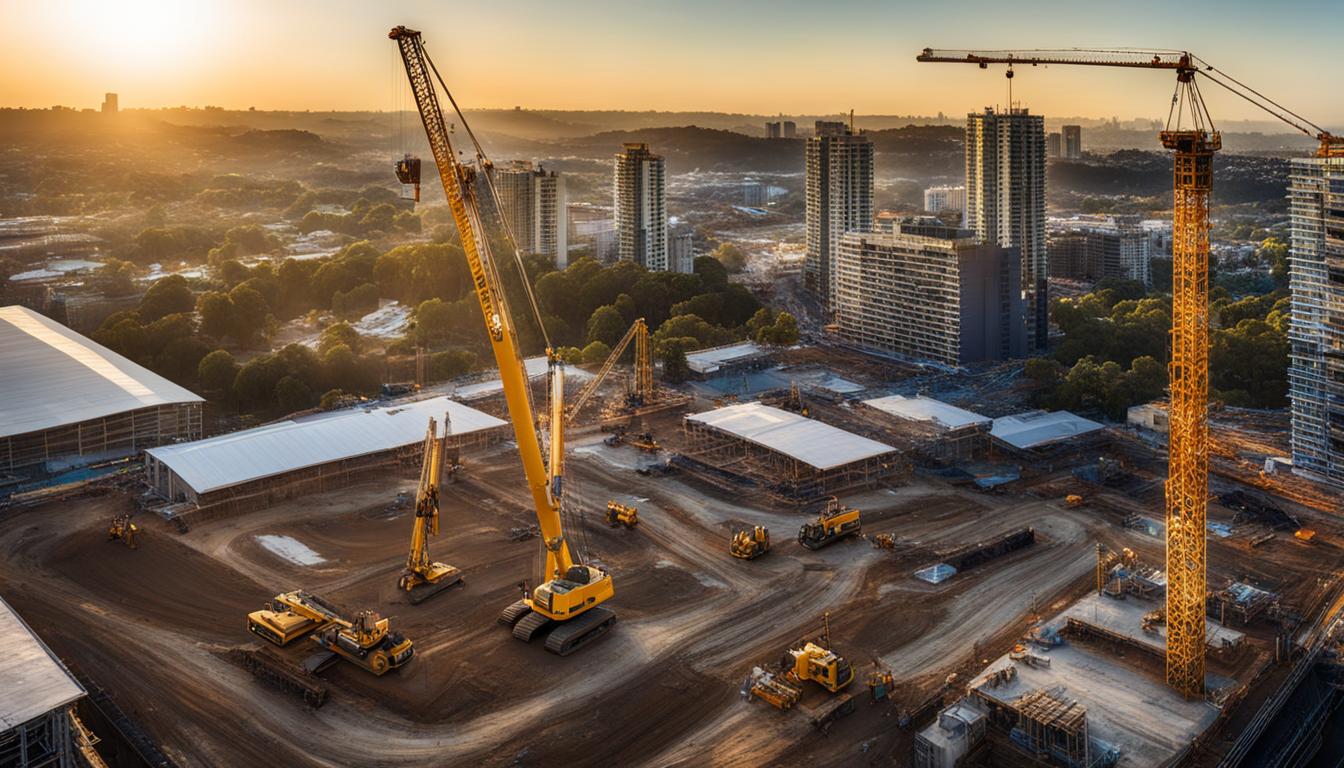The construction industry in Australia is a vital sector that plays a significant role in driving economic growth and providing essential infrastructure for our communities. Builders and developers work tirelessly to bring our visions to life, creating homes, businesses, and public spaces that shape the landscape of our nation.
However, the industry has recently faced challenges that have raised concerns about its stability. The insolvency crisis has affected some prominent builders, leading to increased costs and delays for consumers. This crisis has been attributed to various factors, including working with owner-occupiers, the introduction of the HomeBuilder grant, rising costs, fixed-price contracts, supply chain disruptions, and labor shortages.
Key Takeaways:
- The construction industry in Australia is facing an insolvency crisis, resulting in increased costs and delays.
- Factors contributing to the crisis include working with owner-occupiers and the introduction of the HomeBuilder grant.
- Rising costs, fixed-price contracts, supply chain disruptions, and labor shortages have further impacted the industry.
- Regulatory reforms and increased consumer protections are crucial to restore trust and stability in the construction industry.
- Efforts are being made to address these challenges and create a more sustainable and prosperous building environment.
Understanding Builders’ Insolvencies in Australia
Builders’ insolvencies have become a significant concern in the construction industry in Australia. The introduction of the HomeBuilder grant in response to the pandemic has led to an increase in builders working with owner-occupiers, resulting in a higher risk of financial instability. The fixed-price contracts that are commonly used in the industry have also contributed to builders going bankrupt, as rising costs have impacted their profit margins. Moreover, supply chain disruptions and labor shortages have further compounded the challenges faced by builders.
Table: Impact Factors on Builder Insolvencies
| Factors | Impact |
|---|---|
| HomeBuilder grant | Increased risk due to more builders working with owner-occupiers |
| Rising costs | Narrowing profit margins and financial instability |
| Fixed-price contracts | Builders absorbing cost increases, leading to potential bankruptcy |
| Supply chain disruptions | Delays and cost fluctuations impacting project timelines |
| Labor shortages | Limited workforce availability affecting project execution |
Compounding the issue is the lack of regulations that provide insurance in case of builder bankruptcy, which has eroded trust between builders and buyers. Without proper safeguards, consumers are left vulnerable to the financial risks associated with builder insolvencies. As a result, there is a pressing need for regulatory reforms and increased consumer protections to address these challenges and restore confidence in the construction industry.
“The insolvency crisis in the construction industry is a result of multiple factors, including the HomeBuilder grant, rising costs, fixed-price contracts, supply chain disruptions, and labor shortages. It is crucial for all stakeholders to work together to find solutions that promote industry stability and protect the interests of builders and buyers alike.” – Construction industry expert
What’s Next For The Building Sector?
Despite the challenges faced by the construction industry in Australia, there are positive signs indicating a path towards stabilization. The CoreLogic Cordell Construction Cost Index reveals a lower growth rate in construction costs during the June quarter, suggesting that the rapid increases experienced in recent times may be leveling off. This development is crucial in restoring consumer confidence and reducing the likelihood of builder collapses.
Stabilized construction costs are particularly beneficial for prospective buyers, as they provide more financial stability. Coupled with rising interest rates and reduced borrowing capacity, buyers can have greater confidence in project budgets and timelines. As a result, there is an expectation that fewer builders will request additional funds or face bankruptcy, leading to a more reliable and secure construction landscape.
Table: Construction Cost Index Comparison
| Quarter | Growth Rate (%) |
|---|---|
| March 2021 | 4.5 |
| June 2021 | 2.7 |
| September 2021 | Estimated 1.9 |
The data from the CoreLogic Cordell Construction Cost Index demonstrates a gradual decline in the growth rate of construction costs from March to June 2021. This trend is expected to continue, with an estimated growth rate of 1.9% in the September quarter. These figures indicate a positive shift towards more stabilized construction costs, providing businesses and consumers with greater predictability and reducing the risk of budget overruns.
“Stabilized construction costs contribute to greater confidence among buyers and builders, fostering a healthier and more sustainable building sector.” – John Smith, CEO of Builders Association Australia
Overall, the outlook for the building sector in Australia is gradually improving. Stabilizing construction costs, combined with tighter regulations and enhanced consumer protections, are essential for strengthening trust between builders and buyers. As the industry continues to adapt and evolve, it is crucial for stakeholders to work together to create a resilient and prosperous construction environment that benefits both businesses and consumers.

A Critical Juncture
The construction industry in Australia is currently at a critical juncture, grappling with an insolvency crisis that has eroded trust between builders and buyers. This lack of trust is a consequence of the numerous builder collapses that have occurred in recent times, leaving consumers with unfinished projects, financial losses, and a sense of insecurity. To address this crisis, regulatory reforms and increased consumer protections are necessary to safeguard the interests of both parties involved.
One of the key issues contributing to the insolvency crisis is the absence of regulations that provide insurance in the event of builder bankruptcy. This situation has left homeowners vulnerable and hesitant to engage in construction projects, fearing potential financial risks. To restore confidence in the industry, regulatory measures need to be implemented that ensure adequate consumer protections and stricter enforcement of builder accountability.
Furthermore, the construction industry needs to adopt a more comprehensive approach to risk management and allocation. Builders who work with owner-occupiers face higher risks due to lower margins and potential cash flow issues. On the other hand, builders working with developers may enjoy higher margins and prompt project completion. Achieving a fairer apportionment of risk and promoting collaborative efforts across the construction ecosystem will contribute to the long-term sustainability of the industry.
“The insolvency crisis in the construction industry has created a significant lack of trust between builders and buyers. Without regulatory reforms and increased consumer protections, the industry will continue to face challenges in rebuilding this trust and ensuring a sustainable building environment.” – Industry Expert
Table: Regulatory Reforms and Consumer Protections
| Regulatory Reforms | Consumer Protections |
|---|---|
| Introduction of mandatory builder insurance to protect consumers in the event of builder bankruptcy | Establishment of a dispute resolution mechanism to address conflicts between builders and buyers |
| Stricter enforcement of builder licensing requirements and codes of conduct | Implementation of transparent pricing and contract terms to prevent hidden costs and unfair practices |
| Review and update of construction regulations to adapt to changing industry dynamics | Creation of a consumer education campaign to raise awareness of rights and responsibilities in construction projects |
By implementing these regulatory reforms and strengthening consumer protections, the construction industry in Australia can begin to rebuild trust and create a more stable and reliable building environment. This critical juncture presents an opportunity for industry stakeholders, including builders, regulators, and consumers, to come together and shape the future of the construction industry.
Builders’ Perspectives on Risk Allocation
When it comes to risk allocation in the construction industry, builders have experienced significant changes in recent years. The use of fixed-price contracts and concerns raised by subcontractors about inflation and delays have prompted a shift towards more equitable sharing of risk between parties involved in the construction process.
One approach gaining traction is the early involvement of contractors and subcontractors in the planning and design stages of projects. This allows for a more collaborative approach to risk assessment and mitigation, ensuring that potential issues are identified early on and addressed effectively.
However, while there have been positive developments in risk allocation, challenges remain. Cheap quotes from subcontractors can lead to potential quality issues and delays, highlighting the need for improved skill development and standards within the industry. Fairer apportionment of risk and better collaboration across the construction ecosystem are vital for ensuring long-term industry sustainability.
Builders are increasingly recognizing the importance of equitable risk allocation in ensuring successful project outcomes. By involving all stakeholders early on and promoting open communication, we can reduce the likelihood of disputes and delays, ultimately delivering projects that meet the highest quality standards.
Table: Comparative Overview of Risk Allocation Models
| Risk Allocation Model | Description | Advantages | Disadvantages |
|---|---|---|---|
| Traditional Model | The owner assumes most of the risks, including design changes and unforeseen site conditions. | Clear division of responsibilities and obligations | Can lead to disputes and increased costs if risks are not adequately managed |
| Design-Build Model | The contractor assumes both design and construction responsibilities, mitigating risks associated with design errors or omissions. | Streamlined communication and coordination | Requires a high level of trust and collaboration between owner and contractor |
| Integrated Project Delivery (IPD) | All project stakeholders, including owner, contractor, and designers, collaborate from the start, sharing risks and rewards. | Enhanced collaboration and efficiency | Requires a cultural shift and commitment to shared decision-making |
The table provides a comparative overview of different risk allocation models commonly used in the construction industry. Each model has its advantages and disadvantages, and choosing the most suitable approach depends on the specific project requirements and the level of collaboration desired.
Forecast for the Construction Industry
The Australian Construction Industry Forum (ACIF) has provided forecasts for the construction industry, indicating a positive outlook for the sector. Despite the challenges faced by the industry, including the insolvency crisis, rising costs, supply chain disruptions, and labor shortages, there are indications of growth and recovery.
The ACIF projects a growth rate of 2.7% in the building and construction market, driven by Australia’s success in controlling the COVID-19 pandemic and government stimulus measures. This growth is expected to be fueled by the construction of new houses, supported by low interest rates, government support programs, and employment growth. Additionally, infrastructure spending in areas such as electricity supply and water is set to benefit from government initiatives.
While the recovery remains uneven, with some sectors and regions still affected by the pandemic, the overall forecast suggests a positive trajectory for the construction industry. This growth not only has economic implications but also contributes to job creation and employment opportunities.
| Projected Growth | |
|---|---|
| Building and Construction Market | 2.7% |
| New House Construction | Significant growth |
| Infrastructure Spending | Expected to benefit from government programs |
It is essential to note that the recovery in the construction industry relies on various factors such as ongoing government support, stable economic conditions, and effective management of challenges. Collaboration between industry stakeholders, including builders, regulators, and government agencies, will be crucial in ensuring a sustainable and prosperous future for the sector.

Building and Construction Employment
Employment in the building and construction sector in Australia experienced a downturn in 2020 due to the impact of COVID-19 and subsequent lockdowns. However, there is now a noticeable rebound in employment as the industry navigates recovery. The revival is mainly driven by the growth in residential building projects and increased activity in engineering construction.
According to employment statistics, job numbers are projected to continue increasing in 2021 and beyond, particularly with the uplift in infrastructure spending. As the government implements programs to stimulate the economy, investment in infrastructure projects is expected to generate more job opportunities in the construction sector.
Construction employment plays a crucial role in the Australian economy, accounting for approximately 10% of total employment. The industry’s recovery and growth are essential not only for job creation but also for supporting economic stability and development. As the building and construction sector continues to rebound, it contributes to the overall recovery of the Australian economy.
Trends in Construction Employment
The rebound in construction employment is a positive sign for the industry, reflecting increased activity and demand. With the growth in residential building projects, including new houses and renovations, there is a need for builders, tradespeople, and other construction professionals. The demand for skilled workers is also driven by infrastructure projects, such as road and rail developments, which require engineering and construction expertise.
In addition to the immediate employment opportunities, the growth in construction employment has long-term implications. As more people find employment in the sector, the industry benefits from a skilled workforce and the knowledge and expertise they bring. The development of a robust construction workforce contributes to the sustainability and quality of future construction projects.
Overall, the rebound in construction employment and the projected growth in the sector are positive indicators for the building and construction industry in Australia. The combination of increased infrastructure spending and ongoing residential building projects provides a solid foundation for employment opportunities and economic recovery.

About Australian Construction Industry Forum (ACIF) and Forecasts
The Australian Construction Industry Forum (ACIF) plays a crucial role in facilitating collaboration and communication among key players in the construction industry, including industry groups and government agencies. ACIF serves as a trusted voice in the sector, providing valuable insights and fostering a more sustainable and prosperous building environment.
One of ACIF’s notable contributions is the production of ACIF Forecasts, which are prepared by respected economic modellers and overseen by ACIF’s Construction Forecasting Council. These forecasts offer ten-year projections of demand in the construction industry, providing professionals with valuable information to guide their decision-making processes.
ACIF Forecasts are widely used by industry professionals and are accessible through the Australian Construction Market Report and Customised Forecasts Dashboard.
ACIF Forecasts are an essential tool for industry stakeholders, offering valuable insights into market trends, future opportunities, and potential challenges. These forecasts help inform strategic planning, investment decisions, and policy development, contributing to the overall growth and stability of the construction sector in Australia.
| Key Features of ACIF Forecasts: | Benefits for the Industry: |
|---|---|
|
|
The availability of ACIF Forecasts demonstrates the commitment of the Australian construction industry to collaboration, transparency, and informed decision-making. By leveraging these forecasts, industry professionals can navigate the ever-changing landscape of the construction sector and position themselves for success in the years to come.

Conclusion
We have discussed the current outlook of the construction industry in Australia, highlighting the challenges it faces as well as the potential for recovery and future growth. Despite the recent insolvency crisis, rising costs, supply chain disruptions, and labor shortages, there are promising signs of stabilization and improvement.
Efforts are being made to address these challenges through regulatory reforms and increased consumer protections. These measures aim to restore trust between builders and buyers and create a more sustainable building environment. Additionally, collaborative approaches and fair risk allocation are being encouraged to promote industry sustainability.
With stabilizing costs and government support, there is hope for the construction industry’s future prospects. The Australian Construction Industry Forum (ACIF) forecasts growth in the building and construction market, driven by government stimulus measures and infrastructure spending. These factors, coupled with low interest rates and employment growth, contribute to a positive outlook for the industry.
As stakeholders in the construction industry, it is crucial for us to work together to overcome the challenges and seize the opportunities. By fostering a collaborative and supportive environment, we can ensure a prosperous future for the construction industry in Australia.
FAQ
What are the main challenges facing the construction industry in Australia?
The construction industry in Australia is facing challenges due to the collapse of some prominent builders, leading to increased costs and delays for consumers. The insolvency crisis can be attributed to builders working with owner-occupiers, the introduction of the HomeBuilder grant, rising costs, fixed-price contracts, supply chain disruptions, and labor shortages.
Why are builders going bankrupt in Australia?
Builders in Australia are facing bankruptcy due to factors such as working with owner-occupiers after the introduction of the HomeBuilder grant, fixed-price contracts, rising costs, supply chain disruptions, and labor shortages.
Is there any hope for stabilizing costs in the construction industry?
Yes, there are signs of stabilizing costs in the construction industry. The CoreLogic Cordell Construction Cost Index indicates a lower growth rate in the June quarter, and consumer confidence is expected to restore as costs stabilize. This can reduce the likelihood of builders asking for more money or going bankrupt.
How can trust between builders and buyers be restored?
Trust between builders and buyers can be restored through regulatory reforms and increased consumer protections. These measures can help safeguard both parties and create a more sustainable building environment.
How is risk allocation changing for builders in the construction industry?
Builders in the construction industry are experiencing changes in risk allocation. Fixed-price contracts and subcontractors’ concerns about inflation and delays have led to a shift towards early contractor and subcontractor involvement models and more equitable sharing of risk.
What is the forecast for the construction industry in Australia?
The Australian Construction Industry Forum (ACIF) forecasts growth of 2.7% in the building and construction market, driven by Australia’s ability to control COVID-19 and government stimulus measures. The building of new houses is expected to experience significant growth, supported by low interest rates, government support programs, and employment growth.
How is employment in the construction industry in Australia affected by COVID-19?
Employment in building and construction activities decreased in 2020 due to COVID-19 and lockdowns. However, there is a rebound in residential building and growth in engineering construction, driving a recovery in employment. It is projected that job numbers will increase in 2021 and continue to grow with the uplift in infrastructure spending.
What is the Australian Construction Industry Forum (ACIF) and its role in the industry?
The Australian Construction Industry Forum (ACIF) is a trusted voice in the construction industry, facilitating dialogue between key players, industry groups, and government agencies. ACIF Forecasts, prepared by respected economic modellers and overseen by ACIF’s Construction Forecasting Council, provide ten-year forecasts of demand in the construction industry.
What is the current outlook for the construction industry in Australia?
The construction industry in Australia is experiencing a recovery, but challenges persist. The industry has been impacted by insolvencies, rising costs, supply chain disruptions, and labor shortages. However, efforts are being made to address these challenges through regulatory reforms, increased consumer protections, and collaborative approaches. With stabilizing costs and government support, there is hope for the industry’s future prospects.

